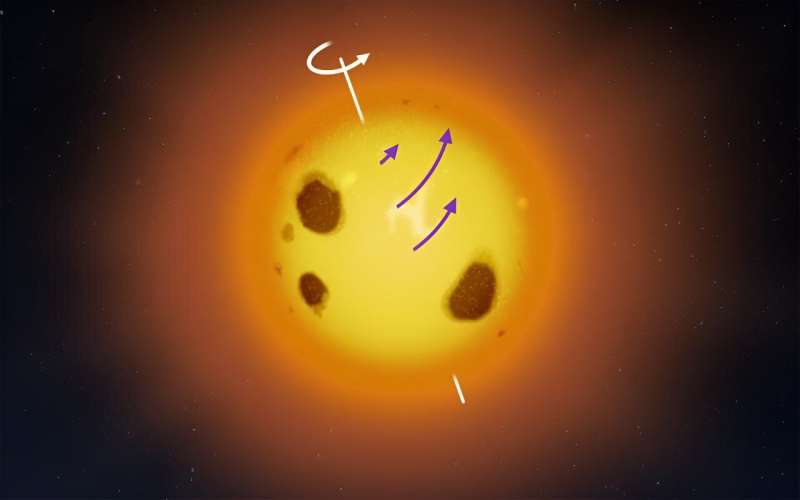This article has been reviewed according to Science X's editorial process and policies. Editors have highlighted the following attributes while ensuring the content's credibility:
fact-checked
peer-reviewed publication
trusted source
proofread
Astronomers find anomalies in star V889 Herculis's rotation

The sun rotates the fastest at the equator, whereas the rotation rate slows down at higher latitudes and is the slowest at the polar regions. But a nearby sun-like star—V889 Herculis, some 115 light years away in the constellation of Hercules—rotates the fastest at a latitude of about 40 degrees, while both the equator and polar regions rotate more slowly. This finding has been published in Astronomy & Astrophysics.
A similar rotational profile has not been observed for any other star. The result is stunning because stellar rotation has been considered a well-understood fundamental physical parameter but such a rotational profile has not been predicted even in computer simulations.
"We applied a newly developed statistical technique to the data of a familiar star that has been studied at the University of Helsinki for years. We did not expect to see such anomalies in stellar rotation. The anomalies in the rotational profile of V889 Herculis indicate that our understanding of stellar dynamics and magnetic dynamos are insufficient," explains researcher Mikko Tuomi, who coordinated the research.
Dynamics of a ball of plasma
The target star V889 Herculis is much like a young sun, telling a story about the history and evolution of our sun. Tuomi emphasizes that it is crucial to understand stellar astrophysics in order to, for instance, predict activity-induced phenomena on the solar surface, such as spots and eruptions.
Stars are spherical structures where matter is in the state of plasma, consisting of charged particles. They are dynamical objects that hang in a balance between the pressure generated in nuclear reactions in their cores and their own gravity. They have no solid surfaces, unlike many planets.
The stellar rotation is not constant for all latitudes—an effect known as differential rotation. It is caused by the fact that hot plasma rises to the star's surface via a phenomenon called convection, which in turn has an effect on the local rotation rate. This is because angular momentum must be conserved and the convection occurs perpendicular to the rotational axis near the equator whereas it is parallel to the axis near the poles.
However, many factors such as stellar mass, age, chemical composition, rotation period, and magnetic field have effects on the rotation and give rise to variations in the differential rotation profiles.
A statistical method for determining rotational profile
Thomas Hackman, docent of astronomy, who participated in the research, explains that the sun has been the only star for which studying the rotational profile has been possible. "Stellar differential rotation is a very crucial factor that has an effect on the magnetic activity of stars. The method we have developed opens a new window into the inner workings of other stars."
The astronomers at the Department of Particle Physics and Astrophysics of Helsinki University have determined the rotational profile of two nearby young stars by applying a new statistical modeling to long-baseline brightness observations. They modeled the periodic variations in the observations by accounting for the differences in the apparent spot movement at different latitudes. The spot movement then enabled estimating the rotational profile of the stars.
The second one of the target stars, LQ Hydrae in the constellation of Hydra, was found to be rotating much like a rigid body—the rotation appeared unchanged from the equator to the poles, which indicates that the differences are very small.
Observations from the Fairborn Observatory
The researchers base their results on the observations of the target stars from the Fairborn observatory. The brightnesses of the stars have been monitored with robotic telescopes for around 30 years, which provides insights into the behavior of the stars over a long period of time.
Tuomi appreciates the work of senior astronomer Gregory Henry, of Tennessee University, United States, who leads the Fairborn observational campaign.
"For many years, Greg's project has been extremely valuable in understanding the behavior of nearby stars. Whether the motivation is to study the rotation and properties of young, active stars or to understand the nature of stars with planets, the observations from Fairborn Observatory have been absolutely crucial.
"It is amazing that even in the era of great space-based observatories we can obtain fundamental information on stellar astrophysics with small 40cm ground-based telescopes."
The target stars V889 Herculis and LQ Hydrae are both roughly 50-million-year-old stars that in many respects resemble the young sun. They both rotate very rapidly, with rotation periods of only about one and half days. For this reason, the long-baseline brightness observations contain many rotational cycles. The stars were selected as targets because they have been observed for decades and because they have both been studied actively at the University of Helsinki.
More information: Mikko Tuomi et al, Characterising the stellar differential rotation based on largest-spot statistics from ground-based photometry, Astronomy & Astrophysics (2024). DOI: 10.1051/0004-6361/202449861
Journal information: Astronomy & Astrophysics
Provided by University of Helsinki




















